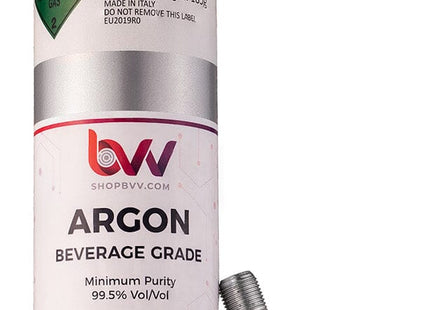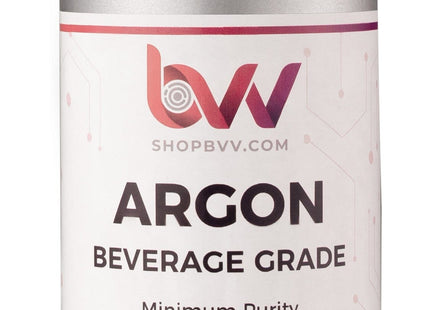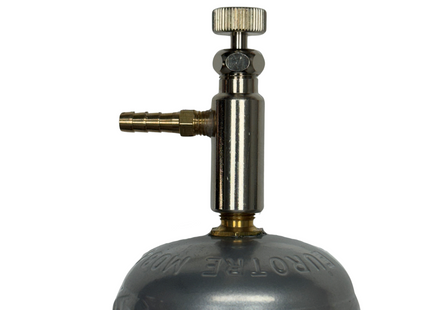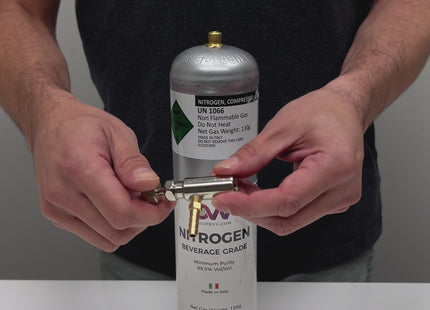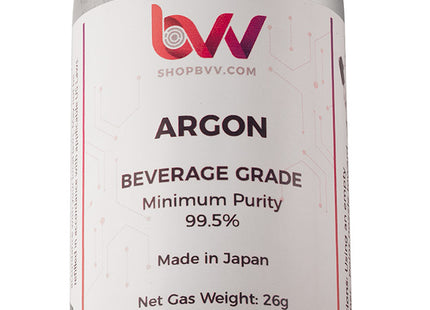Argon Gas 99.5% - Pure gas for preserving terpenes in flowers and concentrates
Description
Argon Gas
Beverage Grade 99.5% Pure
Made in Italy
| Tank Volume of Argon | Coverage | Product Sku: |
| 26g / 14.6 Liters / 3.8 Gallons | ~6.3 lbs of flower | ARGON-26G |
| 185g / 103 Liters / 27 Gallons | ~31.7 lbs of flower | ARGON-130G |
-
14.6 Liters/ with Duster Kit - Thumb touch control button w/ Lock, regulated to 40 PSI. Made in Japan. Thread: 5/8"-18 for use with the 26g Argon Cartridge. 3.5" long nozzle. (Duster Valve can be purchased separately.)
-
103 Liters/ with Regulator Kit - Adjustable via. needle valve, regulated to 80 PSI. Made in Italy. Thread: M11x1 (tank connection). Output: 1/4" Brass Barb, Includes 12" Tygon Tubing. Gauges read in BAR.
-
103 Liters/ with M11 Valve Dispenser Kit - Includes adjustable pushpin style valve dispenser. Output: 1/4" Brass Barb, Includes 12" Tygon Tubing. NO GAUGES
*All single 130g argon tanks come with a plastic nozzle for general dispensing. If the regulator is beyond your budget you can attach a tube of your choice. Nozzle tip diameter 3/8" - Recommend choosing a 3/8" Inside Diameter tube or larger and cut to your desired length. *At end of use, completely empty the tank for recycling.
What Is Argon?
Argon is a chemical element with the symbol "Ar" and atomic number 18. It is a noble gas, which means it belongs to a group of inert and colorless gases that are chemically stable and relatively non-reactive under normal conditions. Argon is the third most abundant gas in the Earth's atmosphere, making up about 0.93% of the air we breathe.
Despite its abundance, argon is mostly used in specialized industrial applications due to its inert and non-reactive properties. It is obtained as a byproduct of the production of liquid oxygen and liquid nitrogen through the fractional distillation of air. In its natural state, argon is odorless, tasteless, and colorless.
What Is Argon Used For?
Argon has a variety of practical and industrial uses due to its inert and non-reactive nature. Some of the key applications of argon include:
-
Welding: Argon is commonly used as a shielding gas in welding processes, such as TIG (Tungsten Inert Gas) and MIG (Metal Inert Gas) welding. It helps prevent oxidation and ensures clean and strong welds.
-
Laboratory Research: Argon is used as a carrier gas in gas chromatography and as an inert atmosphere in scientific laboratories to prevent reactions with sensitive materials.
-
Electronics and Semiconductors: Argon is used in the production of semiconductors and other electronic components, providing a controlled environment for manufacturing processes.
-
Preservation of Perishable Goods: In the food and beverage industry, argon is used to displace oxygen and extend the shelf life of perishable goods, such as wine, by preventing oxidation and spoilage.
-
Medical Applications: Argon is employed in laser surgery and serves as a coolant for superconducting magnets in MRI (Magnetic Resonance Imaging) machines.
-
Deep-Sea Diving: Argon-helium mixtures are used in deep-sea diving to reduce the effects of high pressure on the human body.
-
Lighting: Although less common now, argon was used in incandescent light bulbs to prevent the filament from oxidizing.
-
Metal Manufacturing: Argon is used in the production of metals like titanium and other reactive metals to create a controlled atmosphere.
-
Heat Treating: In heat-treating processes, argon is used as a protective atmosphere to prevent oxidation and maintain the desired material properties.
-
Window Insulation: Argon is sometimes used to fill the space between double or triple-pane windows to improve insulation and energy efficiency.
-
Astronomy: Argon is used in some types of telescopes to create a stable and controlled environment for the detectors.
These applications highlight the versatility of argon in various industries, where its inertness and non-reactivity play a crucial role in maintaining controlled and stable conditions for specific processes.
How Does Argon Preserve Terpenes?
Argon can be used to preserve terpenes through its inert and non-reactive properties. Terpenes are volatile organic compounds responsible for the aroma and flavor of various plants. When exposed to oxygen or other reactive gases, terpenes can degrade or oxidize, leading to a loss of their aromatic and flavor characteristics.
By using argon as a protective gas, you can create an oxygen-free environment that prevents terpenes from coming into contact with reactive molecules. This helps to preserve the integrity of terpenes and maintain their original aroma and flavor profiles. When storing or handling terpene-rich products, such as essential oils or botanical extracts, introducing argon gas can help extend the shelf life and ensure that the product retains its desirable sensory attributes.
Argon's inert nature means it does not chemically interact with the terpenes, preventing unwanted reactions that could lead to degradation. It forms a barrier between the terpenes and the surrounding air, effectively shielding them from oxygen and moisture, both of which can contribute to terpene degradation.
Argon can be a valuable tool for terpene preservation during storage, Helping you preserve the unique terpene profiles of different strains making it crucial for maintaining product quality.
How Does Argon Displace Oxygen?
Argon displaces oxygen through a process called inert gas displacement or dilution. This occurs when argon, which is denser than air, is introduced into an enclosed space, pushing the lighter oxygen molecules upward and out of the area. As a result, the concentration of oxygen in the space decreases, creating an atmosphere that is less conducive to combustion and other chemical reactions.
Here's how the displacement process works:
-
Density Difference: Argon is significantly denser than air, which means it has a higher mass per unit volume. When argon is released into an enclosed space, it naturally sinks to the bottom, displacing the lighter gases like oxygen and nitrogen that make up the atmosphere.
-
Mixing: As argon is introduced, it starts to mix with the existing air in the space. The heavier argon molecules tend to concentrate near the bottom, while the lighter oxygen molecules rise to the top.
-
Oxygen Reduction: As argon continues to fill the space, the concentration of oxygen molecules decreases. Oxygen is gradually pushed upward and out of the area, leading to a lower oxygen content in the atmosphere.
-
Inert Environment: The increasing presence of argon creates an inert environment where oxygen is less available to support oxidation. This is particularly useful in storing oxidizable compounds.
It's important to note that while argon displaces oxygen, it does not chemically react with other gases or substances. Instead, it creates a physical barrier between oxygen and the materials that could ignite or react with it. This property makes argon a valuable tool in fire suppression systems, as well as in applications like food preservation, where a low-oxygen environment helps extend the shelf life of products.
When working with argon, especially in confined spaces, proper safety measures should be followed to prevent oxygen depletion and ensure a safe working environment.
How Do I Use Argon For Flower and Concentrate Storage?
Using argon for flower and concentrate storage is a simple and effective method to help preserve the quality and freshness of your products. Follow these steps to properly use argon gas for storage:
-
Prepare the Container: Start with a clean and empty container that is suitable for storing your flower or concentrate. Ensure that the container has a tight-fitting lid or cap to create a sealed environment.
-
Position the Nozzle: Hold the argon gas canister with the nozzle pointing toward the bottom of the container. This helps ensure that the argon gas displaces any oxygen present in the container.
-
Apply Argon Gas: Press the nozzle to release the argon gas into the container. The recommended dosage is approximately 2 seconds of spraying for every 4 ounces of container volume. This dosage helps create a protective layer of argon gas within the container.
-
Fill the Container: Immediately after applying the argon gas, place your desired flower or concentrate into the container. The argon gas will create a blanket of protection over the material, minimizing its exposure to oxygen.
-
Securely Close the Lid: Once the container is filled with the material, seal it tightly with the lid or cap. Make sure the container is properly closed to maintain the sealed environment.
-
Store in a Cool, Dark Place: Store the sealed container in a cool, dark place to further protect the contents from light and heat. Proper storage conditions are essential for maintaining the quality and potency of your flower or concentrate.
Using argon gas in this manner helps create an oxygen-free atmosphere within the container, reducing the risk of oxidation and degradation of your products. By minimizing oxygen exposure, you can extend the shelf life and preserve the flavors, aromas, and potency of your flower and concentrate.
Remember to always follow safety precautions when handling argon gas, including proper ventilation and avoiding direct inhalation. Additionally, ensure that the argon gas canister is stored and used in accordance with manufacturer guidelines.
How Can I Preserve Wine With Argon?
Preserving wine with argon is a popular method to extend the shelf life of opened bottles and maintain the wine's freshness and flavor. Follow these steps to effectively use argon gas for wine preservation:
-
Gather the Necessary Equipment:
- Argon gas canister with a preservation nozzle or wine preservation system
- An opened bottle of wine with a cork or closure
-
Position the Nozzle: Insert the dispensing line or nozzel into the neck of the wine bottle. If using an argon gas canister with a preservation nozzle, insert the nozzle into the bottle's neck, ensuring a tight fit. If using a wine preservation system, follow the manufacturer's instructions for attaching the system to the bottle.
-
Apply Argon Gas: Press the nozzle to release a short burst of argon gas into the bottle. The argon gas is heavier than air and will displace the oxygen present in the bottle, creating a protective layer on top of the wine.
-
Recap or Recork: Immediately after applying the argon gas, recap the bottle with its original cork or closure. Make sure the closure is securely in place to maintain a seal.
-
Store the Bottle: Store the wine bottle upright in a cool and dark place, away from direct sunlight and temperature fluctuations.
-
Enjoy Over Time: When you're ready to enjoy the wine again, simply remove the closure and pour a glass. The argon gas layer will have helped protect the wine from oxidation, allowing you to savor the wine's original flavors and aromas.
It's important to note that argon gas is denser than air, so it will naturally settle on top of the wine. This layer of argon forms a barrier between the wine and the oxygen, preventing oxidation and preserving the wine's quality.
Using argon gas for wine preservation is a convenient and effective method to enjoy opened bottles of wine over an extended period. It's particularly useful for wines that are meant to be enjoyed gradually, as well as for special bottles that you want to savor over time without worrying about deterioration. Always follow the manufacturer's guidelines for using argon gas for wine preservation and handle the gas canister with care.
| Chemical Formula: | Ar |
| Molecular Weight: | 39.9 g/mol |
| CAS Registry Number: | 7440-37-1 |
| Appearance | Colorless |
| Odor: | Odorless |
| Density |
0.103 lb/ft3 |
| Boiling Point: | N/A |
| Solubility in water: | N/A |
| GHS Pictograms: |  |
| GHS Signal Word: | Warning |
| GHS Hazard Statements: | H280, H281 |
| GHS Precautionary Statements | P282, P336+P317, P403, and P410+P403 |
| UN Identification Number: | 1006 |
| Proper Shipping Name: | Argon, Compressed |
| Transport Hazard Class: | 2.2 |
| Packing Group: | None |
| DOT Placard: |  |
SKU: ARGON-26g
$16.50
You will earn 16.50 points for this purchase.- Want it cheaper? Call us for a wholesale or processor discount. 331-281-0154

